HRM, Compensation, and Talent Management: Comprehensive Analysis
VerifiedAdded on 2022/08/13
|7
|2425
|18
Homework Assignment
AI Summary
This assignment delves into various aspects of Human Resource Management (HRM), compensation, and talent management. It begins with an analysis of a research article on employee perceptions of HRM and its impact on retention and commitment, highlighting the significance of fair treatment and organizational support. The assignment then examines an educational video on Employee Stock Options Plans (ESOPs) for start-ups. Further, the assignment addresses several questions related to incentive plans, HR websites, talent management's role in recruitment, training evaluation, global dual-career couples, compensation philosophies, performance appraisals, and best practices. The responses also include discussions on the use of technology, employee rights, workers' compensation, workplace violence, suggestion box systems, and the effectiveness of different compensation methods. The analysis provides insights into employee engagement, organizational policies, and strategies for fostering a positive and productive work environment.
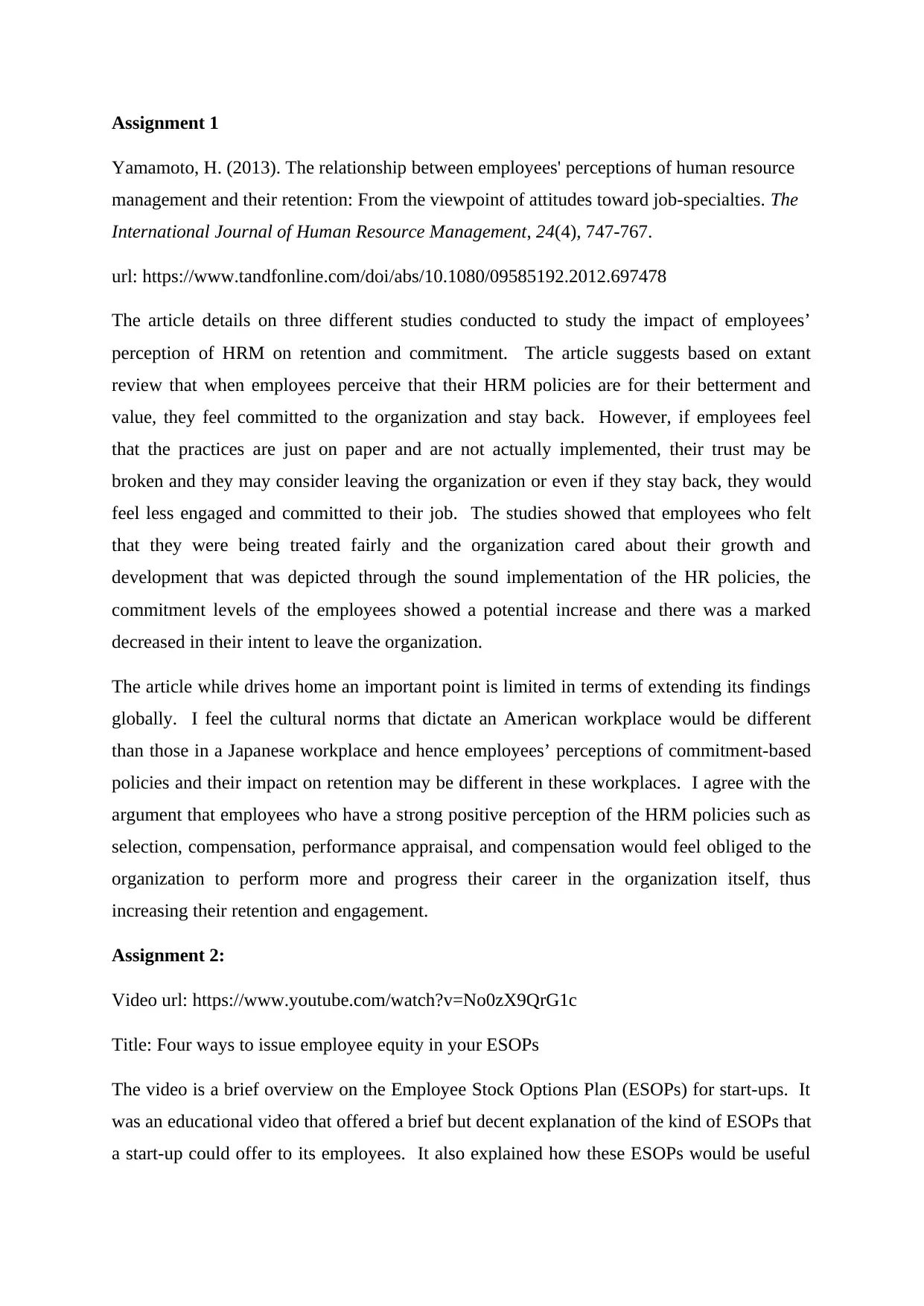
Assignment 1
Yamamoto, H. (2013). The relationship between employees' perceptions of human resource
management and their retention: From the viewpoint of attitudes toward job-specialties. The
International Journal of Human Resource Management, 24(4), 747-767.
url: https://www.tandfonline.com/doi/abs/10.1080/09585192.2012.697478
The article details on three different studies conducted to study the impact of employees’
perception of HRM on retention and commitment. The article suggests based on extant
review that when employees perceive that their HRM policies are for their betterment and
value, they feel committed to the organization and stay back. However, if employees feel
that the practices are just on paper and are not actually implemented, their trust may be
broken and they may consider leaving the organization or even if they stay back, they would
feel less engaged and committed to their job. The studies showed that employees who felt
that they were being treated fairly and the organization cared about their growth and
development that was depicted through the sound implementation of the HR policies, the
commitment levels of the employees showed a potential increase and there was a marked
decreased in their intent to leave the organization.
The article while drives home an important point is limited in terms of extending its findings
globally. I feel the cultural norms that dictate an American workplace would be different
than those in a Japanese workplace and hence employees’ perceptions of commitment-based
policies and their impact on retention may be different in these workplaces. I agree with the
argument that employees who have a strong positive perception of the HRM policies such as
selection, compensation, performance appraisal, and compensation would feel obliged to the
organization to perform more and progress their career in the organization itself, thus
increasing their retention and engagement.
Assignment 2:
Video url: https://www.youtube.com/watch?v=No0zX9QrG1c
Title: Four ways to issue employee equity in your ESOPs
The video is a brief overview on the Employee Stock Options Plan (ESOPs) for start-ups. It
was an educational video that offered a brief but decent explanation of the kind of ESOPs that
a start-up could offer to its employees. It also explained how these ESOPs would be useful
Yamamoto, H. (2013). The relationship between employees' perceptions of human resource
management and their retention: From the viewpoint of attitudes toward job-specialties. The
International Journal of Human Resource Management, 24(4), 747-767.
url: https://www.tandfonline.com/doi/abs/10.1080/09585192.2012.697478
The article details on three different studies conducted to study the impact of employees’
perception of HRM on retention and commitment. The article suggests based on extant
review that when employees perceive that their HRM policies are for their betterment and
value, they feel committed to the organization and stay back. However, if employees feel
that the practices are just on paper and are not actually implemented, their trust may be
broken and they may consider leaving the organization or even if they stay back, they would
feel less engaged and committed to their job. The studies showed that employees who felt
that they were being treated fairly and the organization cared about their growth and
development that was depicted through the sound implementation of the HR policies, the
commitment levels of the employees showed a potential increase and there was a marked
decreased in their intent to leave the organization.
The article while drives home an important point is limited in terms of extending its findings
globally. I feel the cultural norms that dictate an American workplace would be different
than those in a Japanese workplace and hence employees’ perceptions of commitment-based
policies and their impact on retention may be different in these workplaces. I agree with the
argument that employees who have a strong positive perception of the HRM policies such as
selection, compensation, performance appraisal, and compensation would feel obliged to the
organization to perform more and progress their career in the organization itself, thus
increasing their retention and engagement.
Assignment 2:
Video url: https://www.youtube.com/watch?v=No0zX9QrG1c
Title: Four ways to issue employee equity in your ESOPs
The video is a brief overview on the Employee Stock Options Plan (ESOPs) for start-ups. It
was an educational video that offered a brief but decent explanation of the kind of ESOPs that
a start-up could offer to its employees. It also explained how these ESOPs would be useful
Paraphrase This Document
Need a fresh take? Get an instant paraphrase of this document with our AI Paraphraser
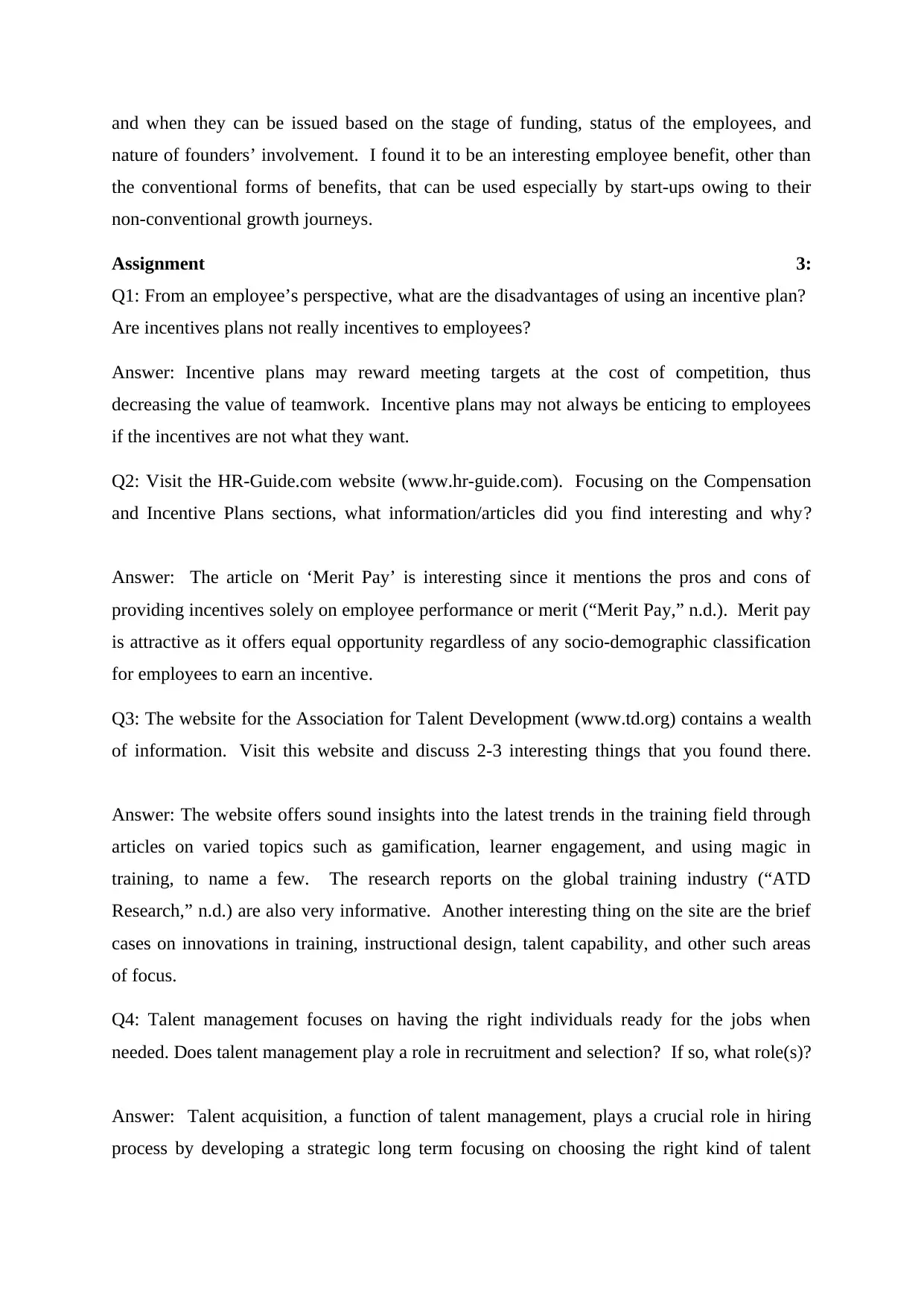
and when they can be issued based on the stage of funding, status of the employees, and
nature of founders’ involvement. I found it to be an interesting employee benefit, other than
the conventional forms of benefits, that can be used especially by start-ups owing to their
non-conventional growth journeys.
Assignment 3:
Q1: From an employee’s perspective, what are the disadvantages of using an incentive plan?
Are incentives plans not really incentives to employees?
Answer: Incentive plans may reward meeting targets at the cost of competition, thus
decreasing the value of teamwork. Incentive plans may not always be enticing to employees
if the incentives are not what they want.
Q2: Visit the HR-Guide.com website (www.hr-guide.com). Focusing on the Compensation
and Incentive Plans sections, what information/articles did you find interesting and why?
Answer: The article on ‘Merit Pay’ is interesting since it mentions the pros and cons of
providing incentives solely on employee performance or merit (“Merit Pay,” n.d.). Merit pay
is attractive as it offers equal opportunity regardless of any socio-demographic classification
for employees to earn an incentive.
Q3: The website for the Association for Talent Development (www.td.org) contains a wealth
of information. Visit this website and discuss 2-3 interesting things that you found there.
Answer: The website offers sound insights into the latest trends in the training field through
articles on varied topics such as gamification, learner engagement, and using magic in
training, to name a few. The research reports on the global training industry (“ATD
Research,” n.d.) are also very informative. Another interesting thing on the site are the brief
cases on innovations in training, instructional design, talent capability, and other such areas
of focus.
Q4: Talent management focuses on having the right individuals ready for the jobs when
needed. Does talent management play a role in recruitment and selection? If so, what role(s)?
Answer: Talent acquisition, a function of talent management, plays a crucial role in hiring
process by developing a strategic long term focusing on choosing the right kind of talent
nature of founders’ involvement. I found it to be an interesting employee benefit, other than
the conventional forms of benefits, that can be used especially by start-ups owing to their
non-conventional growth journeys.
Assignment 3:
Q1: From an employee’s perspective, what are the disadvantages of using an incentive plan?
Are incentives plans not really incentives to employees?
Answer: Incentive plans may reward meeting targets at the cost of competition, thus
decreasing the value of teamwork. Incentive plans may not always be enticing to employees
if the incentives are not what they want.
Q2: Visit the HR-Guide.com website (www.hr-guide.com). Focusing on the Compensation
and Incentive Plans sections, what information/articles did you find interesting and why?
Answer: The article on ‘Merit Pay’ is interesting since it mentions the pros and cons of
providing incentives solely on employee performance or merit (“Merit Pay,” n.d.). Merit pay
is attractive as it offers equal opportunity regardless of any socio-demographic classification
for employees to earn an incentive.
Q3: The website for the Association for Talent Development (www.td.org) contains a wealth
of information. Visit this website and discuss 2-3 interesting things that you found there.
Answer: The website offers sound insights into the latest trends in the training field through
articles on varied topics such as gamification, learner engagement, and using magic in
training, to name a few. The research reports on the global training industry (“ATD
Research,” n.d.) are also very informative. Another interesting thing on the site are the brief
cases on innovations in training, instructional design, talent capability, and other such areas
of focus.
Q4: Talent management focuses on having the right individuals ready for the jobs when
needed. Does talent management play a role in recruitment and selection? If so, what role(s)?
Answer: Talent acquisition, a function of talent management, plays a crucial role in hiring
process by developing a strategic long term focusing on choosing the right kind of talent
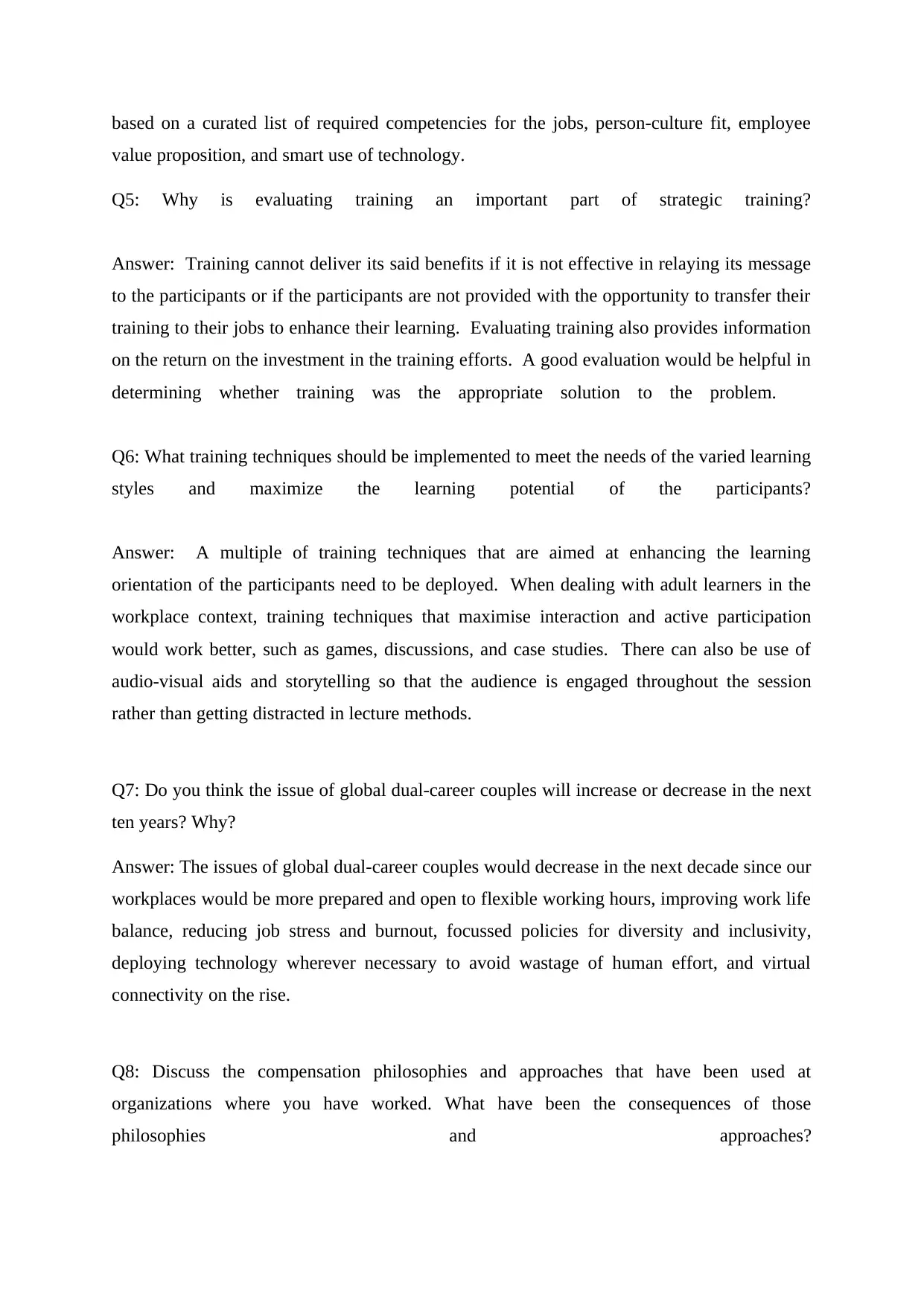
based on a curated list of required competencies for the jobs, person-culture fit, employee
value proposition, and smart use of technology.
Q5: Why is evaluating training an important part of strategic training?
Answer: Training cannot deliver its said benefits if it is not effective in relaying its message
to the participants or if the participants are not provided with the opportunity to transfer their
training to their jobs to enhance their learning. Evaluating training also provides information
on the return on the investment in the training efforts. A good evaluation would be helpful in
determining whether training was the appropriate solution to the problem.
Q6: What training techniques should be implemented to meet the needs of the varied learning
styles and maximize the learning potential of the participants?
Answer: A multiple of training techniques that are aimed at enhancing the learning
orientation of the participants need to be deployed. When dealing with adult learners in the
workplace context, training techniques that maximise interaction and active participation
would work better, such as games, discussions, and case studies. There can also be use of
audio-visual aids and storytelling so that the audience is engaged throughout the session
rather than getting distracted in lecture methods.
Q7: Do you think the issue of global dual-career couples will increase or decrease in the next
ten years? Why?
Answer: The issues of global dual-career couples would decrease in the next decade since our
workplaces would be more prepared and open to flexible working hours, improving work life
balance, reducing job stress and burnout, focussed policies for diversity and inclusivity,
deploying technology wherever necessary to avoid wastage of human effort, and virtual
connectivity on the rise.
Q8: Discuss the compensation philosophies and approaches that have been used at
organizations where you have worked. What have been the consequences of those
philosophies and approaches?
value proposition, and smart use of technology.
Q5: Why is evaluating training an important part of strategic training?
Answer: Training cannot deliver its said benefits if it is not effective in relaying its message
to the participants or if the participants are not provided with the opportunity to transfer their
training to their jobs to enhance their learning. Evaluating training also provides information
on the return on the investment in the training efforts. A good evaluation would be helpful in
determining whether training was the appropriate solution to the problem.
Q6: What training techniques should be implemented to meet the needs of the varied learning
styles and maximize the learning potential of the participants?
Answer: A multiple of training techniques that are aimed at enhancing the learning
orientation of the participants need to be deployed. When dealing with adult learners in the
workplace context, training techniques that maximise interaction and active participation
would work better, such as games, discussions, and case studies. There can also be use of
audio-visual aids and storytelling so that the audience is engaged throughout the session
rather than getting distracted in lecture methods.
Q7: Do you think the issue of global dual-career couples will increase or decrease in the next
ten years? Why?
Answer: The issues of global dual-career couples would decrease in the next decade since our
workplaces would be more prepared and open to flexible working hours, improving work life
balance, reducing job stress and burnout, focussed policies for diversity and inclusivity,
deploying technology wherever necessary to avoid wastage of human effort, and virtual
connectivity on the rise.
Q8: Discuss the compensation philosophies and approaches that have been used at
organizations where you have worked. What have been the consequences of those
philosophies and approaches?
⊘ This is a preview!⊘
Do you want full access?
Subscribe today to unlock all pages.

Trusted by 1+ million students worldwide
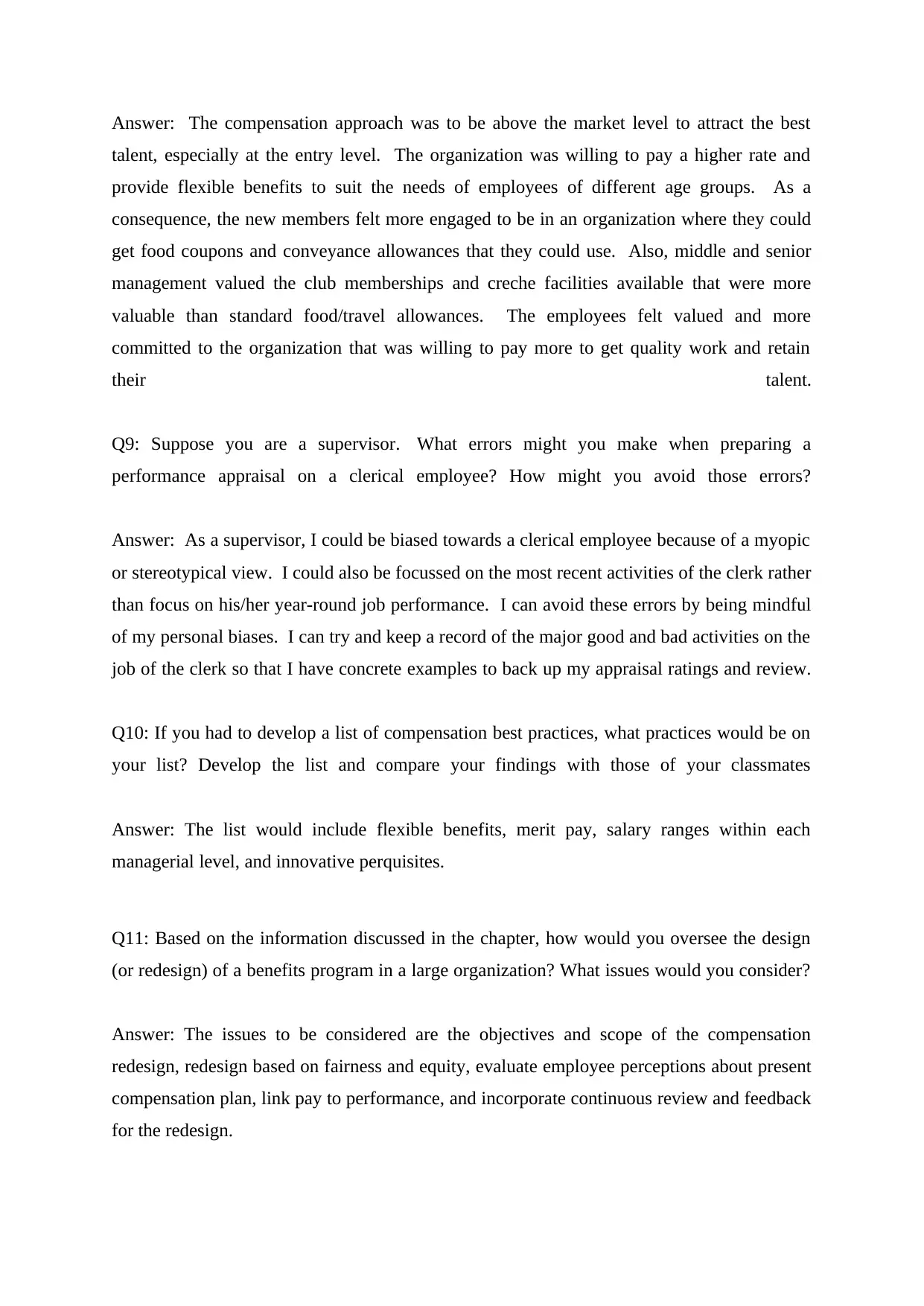
Answer: The compensation approach was to be above the market level to attract the best
talent, especially at the entry level. The organization was willing to pay a higher rate and
provide flexible benefits to suit the needs of employees of different age groups. As a
consequence, the new members felt more engaged to be in an organization where they could
get food coupons and conveyance allowances that they could use. Also, middle and senior
management valued the club memberships and creche facilities available that were more
valuable than standard food/travel allowances. The employees felt valued and more
committed to the organization that was willing to pay more to get quality work and retain
their talent.
Q9: Suppose you are a supervisor. What errors might you make when preparing a
performance appraisal on a clerical employee? How might you avoid those errors?
Answer: As a supervisor, I could be biased towards a clerical employee because of a myopic
or stereotypical view. I could also be focussed on the most recent activities of the clerk rather
than focus on his/her year-round job performance. I can avoid these errors by being mindful
of my personal biases. I can try and keep a record of the major good and bad activities on the
job of the clerk so that I have concrete examples to back up my appraisal ratings and review.
Q10: If you had to develop a list of compensation best practices, what practices would be on
your list? Develop the list and compare your findings with those of your classmates
Answer: The list would include flexible benefits, merit pay, salary ranges within each
managerial level, and innovative perquisites.
Q11: Based on the information discussed in the chapter, how would you oversee the design
(or redesign) of a benefits program in a large organization? What issues would you consider?
Answer: The issues to be considered are the objectives and scope of the compensation
redesign, redesign based on fairness and equity, evaluate employee perceptions about present
compensation plan, link pay to performance, and incorporate continuous review and feedback
for the redesign.
talent, especially at the entry level. The organization was willing to pay a higher rate and
provide flexible benefits to suit the needs of employees of different age groups. As a
consequence, the new members felt more engaged to be in an organization where they could
get food coupons and conveyance allowances that they could use. Also, middle and senior
management valued the club memberships and creche facilities available that were more
valuable than standard food/travel allowances. The employees felt valued and more
committed to the organization that was willing to pay more to get quality work and retain
their talent.
Q9: Suppose you are a supervisor. What errors might you make when preparing a
performance appraisal on a clerical employee? How might you avoid those errors?
Answer: As a supervisor, I could be biased towards a clerical employee because of a myopic
or stereotypical view. I could also be focussed on the most recent activities of the clerk rather
than focus on his/her year-round job performance. I can avoid these errors by being mindful
of my personal biases. I can try and keep a record of the major good and bad activities on the
job of the clerk so that I have concrete examples to back up my appraisal ratings and review.
Q10: If you had to develop a list of compensation best practices, what practices would be on
your list? Develop the list and compare your findings with those of your classmates
Answer: The list would include flexible benefits, merit pay, salary ranges within each
managerial level, and innovative perquisites.
Q11: Based on the information discussed in the chapter, how would you oversee the design
(or redesign) of a benefits program in a large organization? What issues would you consider?
Answer: The issues to be considered are the objectives and scope of the compensation
redesign, redesign based on fairness and equity, evaluate employee perceptions about present
compensation plan, link pay to performance, and incorporate continuous review and feedback
for the redesign.
Paraphrase This Document
Need a fresh take? Get an instant paraphrase of this document with our AI Paraphraser
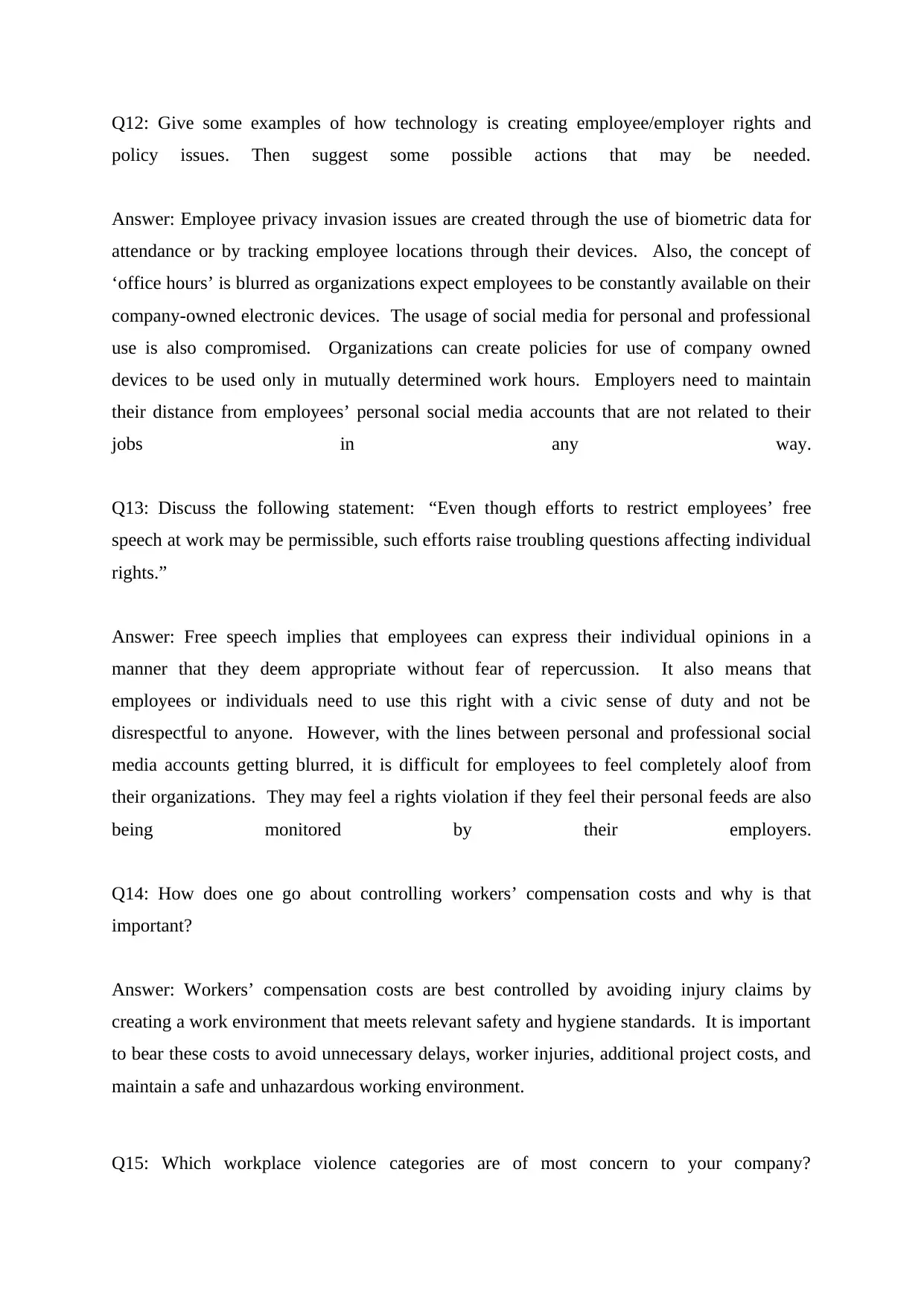
Q12: Give some examples of how technology is creating employee/employer rights and
policy issues. Then suggest some possible actions that may be needed.
Answer: Employee privacy invasion issues are created through the use of biometric data for
attendance or by tracking employee locations through their devices. Also, the concept of
‘office hours’ is blurred as organizations expect employees to be constantly available on their
company-owned electronic devices. The usage of social media for personal and professional
use is also compromised. Organizations can create policies for use of company owned
devices to be used only in mutually determined work hours. Employers need to maintain
their distance from employees’ personal social media accounts that are not related to their
jobs in any way.
Q13: Discuss the following statement: “Even though efforts to restrict employees’ free
speech at work may be permissible, such efforts raise troubling questions affecting individual
rights.”
Answer: Free speech implies that employees can express their individual opinions in a
manner that they deem appropriate without fear of repercussion. It also means that
employees or individuals need to use this right with a civic sense of duty and not be
disrespectful to anyone. However, with the lines between personal and professional social
media accounts getting blurred, it is difficult for employees to feel completely aloof from
their organizations. They may feel a rights violation if they feel their personal feeds are also
being monitored by their employers.
Q14: How does one go about controlling workers’ compensation costs and why is that
important?
Answer: Workers’ compensation costs are best controlled by avoiding injury claims by
creating a work environment that meets relevant safety and hygiene standards. It is important
to bear these costs to avoid unnecessary delays, worker injuries, additional project costs, and
maintain a safe and unhazardous working environment.
Q15: Which workplace violence categories are of most concern to your company?
policy issues. Then suggest some possible actions that may be needed.
Answer: Employee privacy invasion issues are created through the use of biometric data for
attendance or by tracking employee locations through their devices. Also, the concept of
‘office hours’ is blurred as organizations expect employees to be constantly available on their
company-owned electronic devices. The usage of social media for personal and professional
use is also compromised. Organizations can create policies for use of company owned
devices to be used only in mutually determined work hours. Employers need to maintain
their distance from employees’ personal social media accounts that are not related to their
jobs in any way.
Q13: Discuss the following statement: “Even though efforts to restrict employees’ free
speech at work may be permissible, such efforts raise troubling questions affecting individual
rights.”
Answer: Free speech implies that employees can express their individual opinions in a
manner that they deem appropriate without fear of repercussion. It also means that
employees or individuals need to use this right with a civic sense of duty and not be
disrespectful to anyone. However, with the lines between personal and professional social
media accounts getting blurred, it is difficult for employees to feel completely aloof from
their organizations. They may feel a rights violation if they feel their personal feeds are also
being monitored by their employers.
Q14: How does one go about controlling workers’ compensation costs and why is that
important?
Answer: Workers’ compensation costs are best controlled by avoiding injury claims by
creating a work environment that meets relevant safety and hygiene standards. It is important
to bear these costs to avoid unnecessary delays, worker injuries, additional project costs, and
maintain a safe and unhazardous working environment.
Q15: Which workplace violence categories are of most concern to your company?
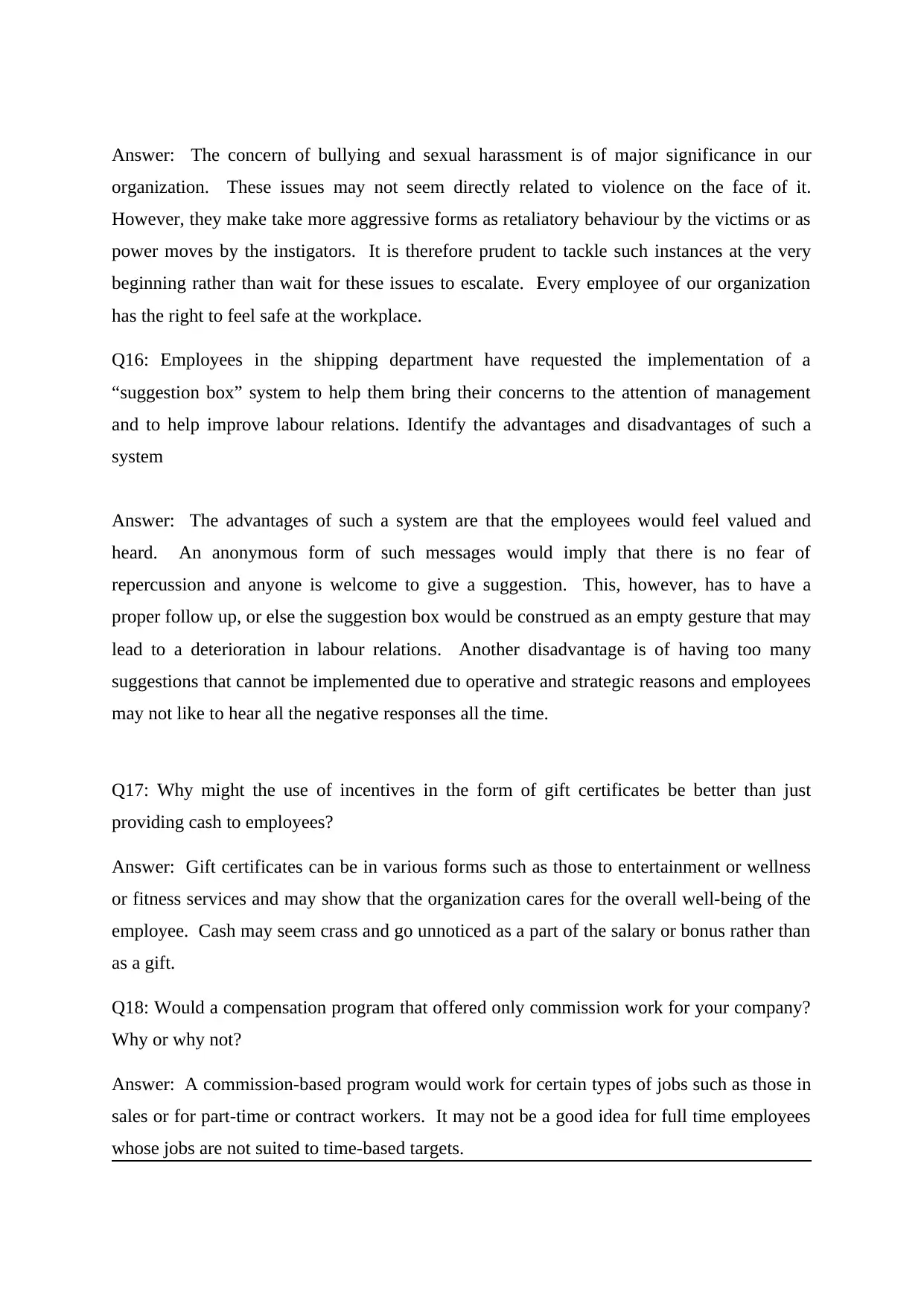
Answer: The concern of bullying and sexual harassment is of major significance in our
organization. These issues may not seem directly related to violence on the face of it.
However, they make take more aggressive forms as retaliatory behaviour by the victims or as
power moves by the instigators. It is therefore prudent to tackle such instances at the very
beginning rather than wait for these issues to escalate. Every employee of our organization
has the right to feel safe at the workplace.
Q16: Employees in the shipping department have requested the implementation of a
“suggestion box” system to help them bring their concerns to the attention of management
and to help improve labour relations. Identify the advantages and disadvantages of such a
system
Answer: The advantages of such a system are that the employees would feel valued and
heard. An anonymous form of such messages would imply that there is no fear of
repercussion and anyone is welcome to give a suggestion. This, however, has to have a
proper follow up, or else the suggestion box would be construed as an empty gesture that may
lead to a deterioration in labour relations. Another disadvantage is of having too many
suggestions that cannot be implemented due to operative and strategic reasons and employees
may not like to hear all the negative responses all the time.
Q17: Why might the use of incentives in the form of gift certificates be better than just
providing cash to employees?
Answer: Gift certificates can be in various forms such as those to entertainment or wellness
or fitness services and may show that the organization cares for the overall well-being of the
employee. Cash may seem crass and go unnoticed as a part of the salary or bonus rather than
as a gift.
Q18: Would a compensation program that offered only commission work for your company?
Why or why not?
Answer: A commission-based program would work for certain types of jobs such as those in
sales or for part-time or contract workers. It may not be a good idea for full time employees
whose jobs are not suited to time-based targets.
organization. These issues may not seem directly related to violence on the face of it.
However, they make take more aggressive forms as retaliatory behaviour by the victims or as
power moves by the instigators. It is therefore prudent to tackle such instances at the very
beginning rather than wait for these issues to escalate. Every employee of our organization
has the right to feel safe at the workplace.
Q16: Employees in the shipping department have requested the implementation of a
“suggestion box” system to help them bring their concerns to the attention of management
and to help improve labour relations. Identify the advantages and disadvantages of such a
system
Answer: The advantages of such a system are that the employees would feel valued and
heard. An anonymous form of such messages would imply that there is no fear of
repercussion and anyone is welcome to give a suggestion. This, however, has to have a
proper follow up, or else the suggestion box would be construed as an empty gesture that may
lead to a deterioration in labour relations. Another disadvantage is of having too many
suggestions that cannot be implemented due to operative and strategic reasons and employees
may not like to hear all the negative responses all the time.
Q17: Why might the use of incentives in the form of gift certificates be better than just
providing cash to employees?
Answer: Gift certificates can be in various forms such as those to entertainment or wellness
or fitness services and may show that the organization cares for the overall well-being of the
employee. Cash may seem crass and go unnoticed as a part of the salary or bonus rather than
as a gift.
Q18: Would a compensation program that offered only commission work for your company?
Why or why not?
Answer: A commission-based program would work for certain types of jobs such as those in
sales or for part-time or contract workers. It may not be a good idea for full time employees
whose jobs are not suited to time-based targets.
⊘ This is a preview!⊘
Do you want full access?
Subscribe today to unlock all pages.

Trusted by 1+ million students worldwide
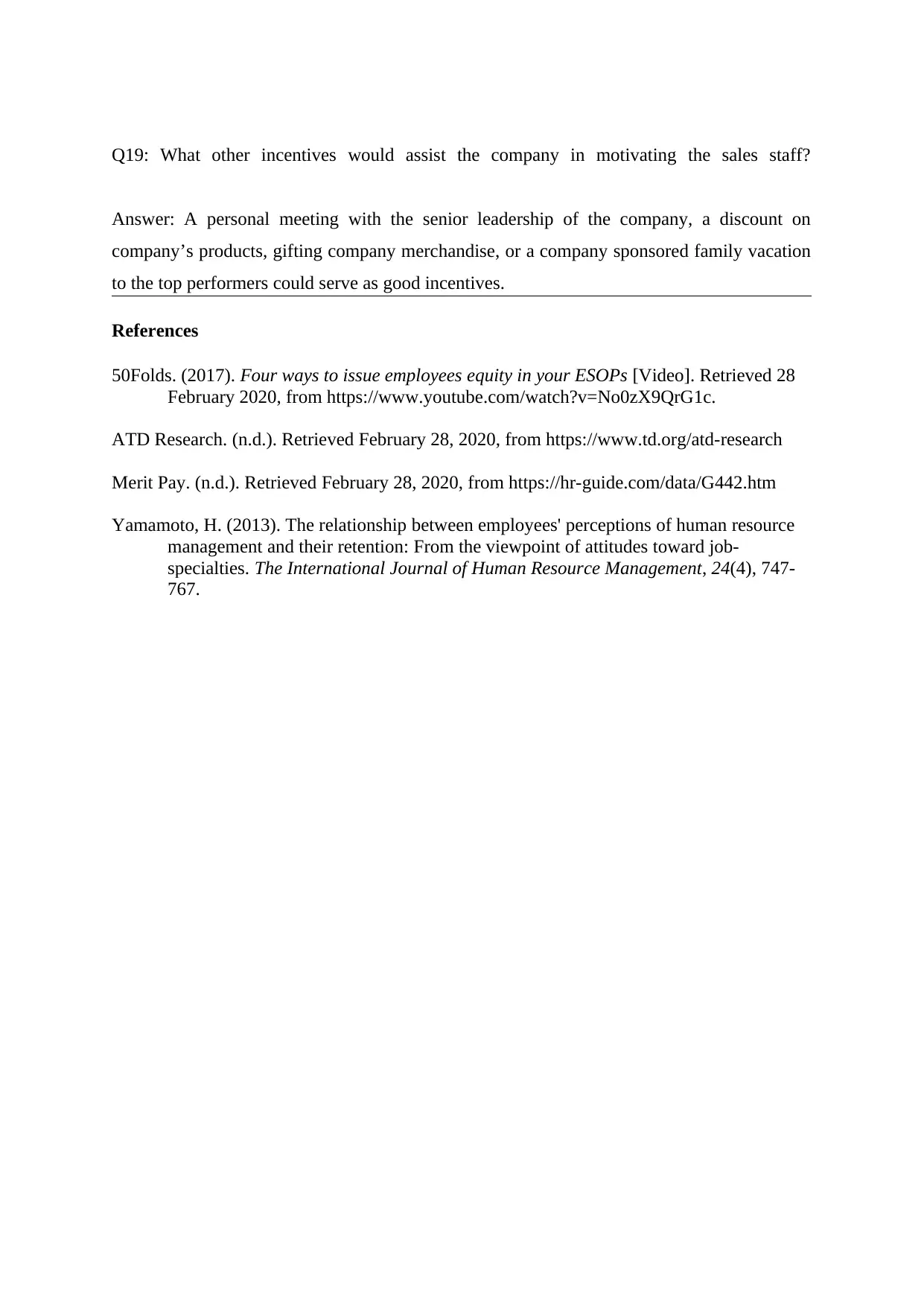
Q19: What other incentives would assist the company in motivating the sales staff?
Answer: A personal meeting with the senior leadership of the company, a discount on
company’s products, gifting company merchandise, or a company sponsored family vacation
to the top performers could serve as good incentives.
References
50Folds. (2017). Four ways to issue employees equity in your ESOPs [Video]. Retrieved 28
February 2020, from https://www.youtube.com/watch?v=No0zX9QrG1c.
ATD Research. (n.d.). Retrieved February 28, 2020, from https://www.td.org/atd-research
Merit Pay. (n.d.). Retrieved February 28, 2020, from https://hr-guide.com/data/G442.htm
Yamamoto, H. (2013). The relationship between employees' perceptions of human resource
management and their retention: From the viewpoint of attitudes toward job-
specialties. The International Journal of Human Resource Management, 24(4), 747-
767.
Answer: A personal meeting with the senior leadership of the company, a discount on
company’s products, gifting company merchandise, or a company sponsored family vacation
to the top performers could serve as good incentives.
References
50Folds. (2017). Four ways to issue employees equity in your ESOPs [Video]. Retrieved 28
February 2020, from https://www.youtube.com/watch?v=No0zX9QrG1c.
ATD Research. (n.d.). Retrieved February 28, 2020, from https://www.td.org/atd-research
Merit Pay. (n.d.). Retrieved February 28, 2020, from https://hr-guide.com/data/G442.htm
Yamamoto, H. (2013). The relationship between employees' perceptions of human resource
management and their retention: From the viewpoint of attitudes toward job-
specialties. The International Journal of Human Resource Management, 24(4), 747-
767.
1 out of 7
Your All-in-One AI-Powered Toolkit for Academic Success.
+13062052269
info@desklib.com
Available 24*7 on WhatsApp / Email
![[object Object]](/_next/static/media/star-bottom.7253800d.svg)
Unlock your academic potential
Copyright © 2020–2025 A2Z Services. All Rights Reserved. Developed and managed by ZUCOL.


